
Concept explainers
Draw the products formed in each reaction.
a. ![]() f.
f. 
b. ![]() g.
g. 
c.  h.
h.
d.  i.
i. 
e.  j.
j. 
(a)
Interpretation: The product formed in the given reaction is to be drawn.
Concept introduction: The treatment of
Answer to Problem 26.32P
The product of the given reaction is,
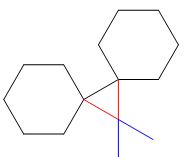
Explanation of Solution
The given reaction involves treatment of an alkene with
The treatment of
The corresponding reaction is shown below.

Figure 1
Thus, the product of the given reaction is,

Figure 2
The product of the given reaction is drawn in Figure 2.
(b)
Interpretation: The product formed in the given reaction is to be drawn.
Concept introduction: The treatment of an organic halide with an alkene in the presence of
Answer to Problem 26.32P
The product of the given reaction is,

Explanation of Solution
The given reaction involves treatment of an organic halide with an alkene in the presence of
The treatment of an organic halide with an alkene in the presence of
The corresponding reaction is shown below.

Figure 3
Thus, the product of the given reaction is,

Figure 4
The product of the given reaction is drawn in Figure 4.
(c)
Interpretation: The product formed in the given reaction is to be drawn.
Concept introduction: The treatment of an organic halide with an alkene in the presence of
Answer to Problem 26.32P
The product of the given reaction is,
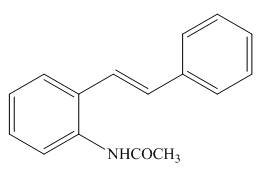
Explanation of Solution
The given reaction involves treatment of an organic halide with an alkene in the presence of
The treatment of an organic halide with an alkene in the presence of
The corresponding reaction is shown below.

Figure 5
Thus, the product of the given reaction is,

Figure 6
The product of the given reaction is drawn in Figure 6.
(d)
Interpretation: The product formed in the given reaction is to be drawn.
Concept introduction: The treatment of an organic halide
Answer to Problem 26.32P
The product of the given reaction is,
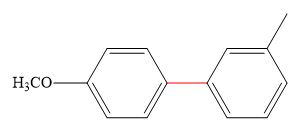
Explanation of Solution
The given reaction involves treatment of an organic halide with an organoborane reagent in the presence of
The treatment of an organic halide
The corresponding reaction is shown below.

Figure 7
Thus, the product of the given reaction is,

Figure 8
The product of the given reaction is drawn in Figure 8.
(e)
Interpretation: The product formed in the given reaction is to be drawn.
Concept introduction: The treatment of an organic halide
Answer to Problem 26.32P
The product of the given reaction is,

Explanation of Solution
The given reaction involves treatment of an organic halide with an organoborane reagent in the presence of
The treatment of an organic halide
The corresponding reaction is shown below.

Figure 9
Thus, the product of the given reaction is,

Figure 10
The product of the given reaction is drawn in Figure 10.
(f)
Interpretation: The product formed in the given reaction is to be drawn.
Concept introduction: The ring-closing metathesis (RCM) by Grubbs catalyst occurs, when the starting material is diene. This reaction is facilitated under high-dilution condition as it favors intramolecular metathesis instead of intermolecular metathesis.
Answer to Problem 26.32P
The product of the given reaction is,
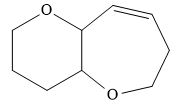
Explanation of Solution
The given reaction involves treatment of a diene with Grubbs catalyst.
The ring-closing metathesis (RCM) by Grubbs catalyst occurs, when the starting material is diene. This reaction is facilitated under high-dilution condition as it favors intramolecular metathesis instead of intermolecular metathesis.
The corresponding reaction is shown below.
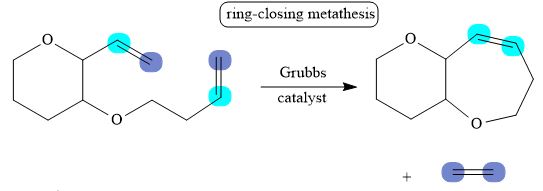
Figure 11
Thus, the product of the given reaction is,

Figure 12
The product of the given reaction is drawn in Figure 12.
(g)
Interpretation: The product formed in the given reaction is to be drawn.
Concept introduction: The nonhalogenated cyclopropanes are synthesized by the treatment of an alkene with
Answer to Problem 26.32P
The product of the given reaction is,
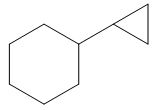
Explanation of Solution
The given reaction involves treatment of an alkene with
The nonhalogenated cyclopropanes are synthesized by the treatment of an alkene with
The corresponding reaction is shown below.

Figure 13
Thus, the product of the given reaction is,

Figure 14
The product of the given reaction is drawn in Figure 14.
(h)
Interpretation: The product formed in the given reaction is to be drawn.
Concept introduction: The treatment of
Answer to Problem 26.32P
The product of the given reaction is,
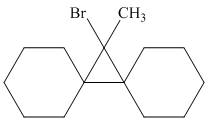
Explanation of Solution
The given reaction involves treatment of product formed in part (a) with
The dihalocyclopropane ring is converted to corresponding bromomethylcyclopropane by the treatment of given organocuprate reagent that is
The corresponding reaction is shown below.
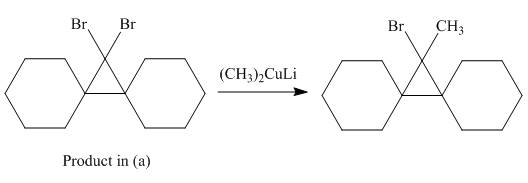
Figure 15
Thus, the product of the given reaction is,

Figure 16
The product of the given reaction is drawn in Figure 16.
(i)
Interpretation: The product formed in the given reaction is to be drawn.
Concept introduction: The treatment of an organic halide with
Answer to Problem 26.32P
The product of the given reaction is,
![]()
Explanation of Solution
The given reaction involves treatment of chlorobutane with
The treatment of an organic halide with
The corresponding reaction is shown below.

Figure 17
Thus, the product of the given reaction is,
![]()
Figure 18
The product of the given reaction is drawn in Figure 18.
(j)
Interpretation: The product formed in the given reaction is to be drawn.
Concept introduction: The treatment of an organic halide
Answer to Problem 26.32P
The product of the given reaction is,
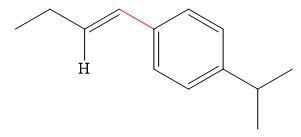
Explanation of Solution
The given reaction involves treatment of an alkyne with an vinylborane, followed by treatment with organic halide in the presence of
The treatment of given alkyne with catecholborane leads to the formation of corresponding vinylborane in first step. This vinylborane (an organoborane) is formed by hydroboration which adds
The treatment of an organic halide
The corresponding reaction is shown below.
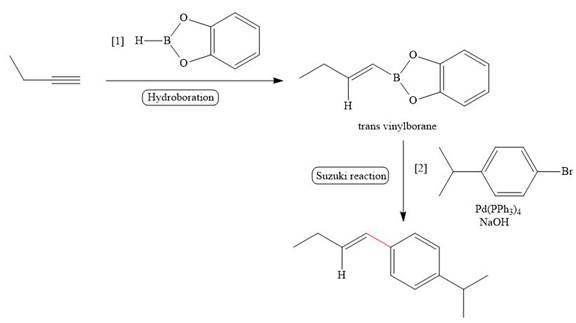
Figure 19
Thus, the product of the given reaction is,

Figure 20
The product of the given reaction is drawn in Figure 20.
Want to see more full solutions like this?
Chapter 26 Solutions
Organic Chemistry-Package(Custom)
- The sum of the numbers in the name of isA. 11; B. 13; C. 10; D. 12; E. none of the other answers iscorrect. I believe the awnser should be E to this problem but the solution to this problem is D 12. I'm honestly unsure how that's the solution. If you can please explain the steps to this type of problem and how to approach a problem like this it would be greatly appreciated!arrow_forwardConsider the following data for phosphorus: g atomic mass 30.974 mol electronegativity 2.19 kJ electron affinity 72. mol kJ ionization energy 1011.8 mol kJ heat of fusion 0.64 mol You may find additional useful data in the ALEKS Data tab. Does the following reaction absorb or release energy? 2+ + (1) P (g) + e → P (g) Is it possible to calculate the amount of energy absorbed or released by reaction (1) using only the data above? If you answered yes to the previous question, enter the amount of energy absorbed or released by reaction (1): Does the following reaction absorb or release energy? 00 release absorb Can't be decided with the data given. yes no ☐ kJ/mol (²) P* (8) + + + e →>> P (g) Is it possible to calculate the amount of energy absorbed or released by reaction (2) using only the data above? If you answered yes to the previous question, enter the amount of energy absorbed or released by reaction (2): ☐ release absorb Can't be decided with the data given. yes no kJ/mol аarrow_forwardThe number of hydrogens in an alkyne that has a main chain of 14carbons to which are attached a cyclobutyl ring, a benzene ring, an–OH group, and a Br is A. 34; B. 35; C. 36; D. 24; E. 43arrow_forward
- Hello! I have a 500 Hz H-NMR for 1,5-bis-(4-methoxyphenyl)-penta-1,4-dien-3-one. I need to label the signals with the corresponding H's. Then, find out if the two alkenes are cis or trans by calculating the J values. I believe that I have the H-NMR labeled correctly, but not sure if I got the J values correct to determine if the two alkenes in the compound will make the compound cis or trans.arrow_forwardWhat is the only possible H-Sb-H bond angle in SbH3?arrow_forwardpls helparrow_forward
- Don't used hand raiting and don't used Ai solution and correct answerarrow_forwardDon't used hand raiting and don't used Ai solution and correct answerarrow_forwardPredict the product formed when the compound shown below undergoes a reaction with MCPBA in CH2Cl2. MCPBA is meta-chloroperoxybenzoic acid.arrow_forward
 ChemistryChemistryISBN:9781305957404Author:Steven S. Zumdahl, Susan A. Zumdahl, Donald J. DeCostePublisher:Cengage Learning
ChemistryChemistryISBN:9781305957404Author:Steven S. Zumdahl, Susan A. Zumdahl, Donald J. DeCostePublisher:Cengage Learning ChemistryChemistryISBN:9781259911156Author:Raymond Chang Dr., Jason Overby ProfessorPublisher:McGraw-Hill Education
ChemistryChemistryISBN:9781259911156Author:Raymond Chang Dr., Jason Overby ProfessorPublisher:McGraw-Hill Education Principles of Instrumental AnalysisChemistryISBN:9781305577213Author:Douglas A. Skoog, F. James Holler, Stanley R. CrouchPublisher:Cengage Learning
Principles of Instrumental AnalysisChemistryISBN:9781305577213Author:Douglas A. Skoog, F. James Holler, Stanley R. CrouchPublisher:Cengage Learning Organic ChemistryChemistryISBN:9780078021558Author:Janice Gorzynski Smith Dr.Publisher:McGraw-Hill Education
Organic ChemistryChemistryISBN:9780078021558Author:Janice Gorzynski Smith Dr.Publisher:McGraw-Hill Education Chemistry: Principles and ReactionsChemistryISBN:9781305079373Author:William L. Masterton, Cecile N. HurleyPublisher:Cengage Learning
Chemistry: Principles and ReactionsChemistryISBN:9781305079373Author:William L. Masterton, Cecile N. HurleyPublisher:Cengage Learning Elementary Principles of Chemical Processes, Bind...ChemistryISBN:9781118431221Author:Richard M. Felder, Ronald W. Rousseau, Lisa G. BullardPublisher:WILEY
Elementary Principles of Chemical Processes, Bind...ChemistryISBN:9781118431221Author:Richard M. Felder, Ronald W. Rousseau, Lisa G. BullardPublisher:WILEY





